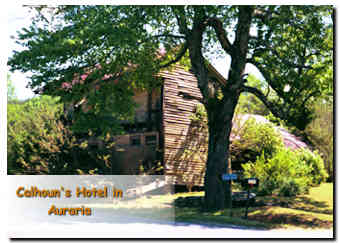|


Georgia Gold Rush
Much has been written as to who
discovered gold in Georgia and when. Mines operated illegally in
Cherokee Territory for years, but the first contemporary reference
to a gold mining operation in the state points to present-day White
County (then Habersham County) in 1829. By then at least two mines
had been constructed in the Nacoochee Valley and there are
indications are they were in operation in late 1828. Most modern
historians and the state of Georgia discount the story of Benjamin
Parks discovering gold at Licklog (Dahlonega,
Lumpkin Co.).
Few words in the English language
create the fervor that the cry of "Gold" does in man. A driving
force in the colonization of America, gold was the primary reason
for Hernando De
Soto to visit the North Georgia region in the early 1540's.
Indians along the Chattahoochee River north of Atlanta routinely
panned for gold and found significant amounts of the material.
Spanish miners joined them and formed minor settlements that
operated almost continuously until the early 1700's.
After the Spanish were forced from
Georgia, interest in gold died for a number of years, but mining
continued off and on throughout 18th century and into the 19th
century. As early as 1819 there is evidence that gold was being
mined by whites near the Cherokee town of Sixes. Although people
knew of the gold, Frank Logan "discovered" it in White County in
1828. Benjamin Parks is frequently credited with the discovery in
Lumpkin County
mostly because that's what he told anybody who would listen to him
for almost 70 years. By 1829 mining operations had begun in White
County (then part of Habersham County). Later that same year
operations began in
Lumpkin, Union,
and Cherokee . This
promise of easy money literally floating down a river brought large
amounts of men and money into the region. It also caused much pain.
The
Cherokee
controlled most of the land in the gold region. The Georgia
legislature began to plan their removal almost immediately after the
discovery of gold. This eventually led to the "Trail
of Tears."
 By
1830 more than 300 ounces a day were being produced in the area from
north of Blairsville to the southeast corner of what is now
Cherokee County.
The center of gold production shifted to Auraria (Latin for "City of
Gold"), just south of Dahlonega (Licklog). It became a boom town
overnight and quickly had a major road, newspaper, post office and
hotel owned by John C. Calhoun, then Vice-President of the United
States. There was so much gold being produced in the region that the
Federal government completed a mint in Dahlonega in 1838, however by
that time production had begun to decrease. The rush continued until
1849, when word of gold in California reached Georgia and many of
the miners left. By 1858, most of the gold mining had ceased. That
year, hydraulic mining was introduced to the state. Production of
gold reached a low point during the Civil War, but by 1880 mining
was again flourishing, thanks to hydraulic mining, which devastated
the environment. Although mining continues in the area today,
production has been decreasing steadily since 1915. By
1830 more than 300 ounces a day were being produced in the area from
north of Blairsville to the southeast corner of what is now
Cherokee County.
The center of gold production shifted to Auraria (Latin for "City of
Gold"), just south of Dahlonega (Licklog). It became a boom town
overnight and quickly had a major road, newspaper, post office and
hotel owned by John C. Calhoun, then Vice-President of the United
States. There was so much gold being produced in the region that the
Federal government completed a mint in Dahlonega in 1838, however by
that time production had begun to decrease. The rush continued until
1849, when word of gold in California reached Georgia and many of
the miners left. By 1858, most of the gold mining had ceased. That
year, hydraulic mining was introduced to the state. Production of
gold reached a low point during the Civil War, but by 1880 mining
was again flourishing, thanks to hydraulic mining, which devastated
the environment. Although mining continues in the area today,
production has been decreasing steadily since 1915.
 Some
people say the streets of Atlanta are paved with gold and they are.
Building materials from North Georgia frequently have measurable
amounts of the metal in them. In fact, when the Mint was torn down
bricks used to build it were crushed and the gold was extracted.
After heavy rains the employees of water treatment plants in Atlanta
have found gold nuggets. Runoff from rivers like the Chattahoochee
and Peachtree Creek does contain small amounts of the metal. Some
people say the streets of Atlanta are paved with gold and they are.
Building materials from North Georgia frequently have measurable
amounts of the metal in them. In fact, when the Mint was torn down
bricks used to build it were crushed and the gold was extracted.
After heavy rains the employees of water treatment plants in Atlanta
have found gold nuggets. Runoff from rivers like the Chattahoochee
and Peachtree Creek does contain small amounts of the metal.
In 1958 the citizens of Dahlonega
presented the state with a gift of gold. The metal was pounded into
thin sheets and attached to the top of the State House in Atlanta.
The gold dome remains as a lasting symbol to the first of our
nation's gold rushes.
 Author
David Williams gives one of the best documented descriptions of
miners, their lives and the terrible pain that was inflicted on the
Cherokee Nation because of The Georgia Gold Rush / (Twenty-niners,
Cherokees, and Gold Fever). About North Georgia recommends the
book for anyone with an interest in the gold rush, Georgia history,
or the Cherokee Removal. Author
David Williams gives one of the best documented descriptions of
miners, their lives and the terrible pain that was inflicted on the
Cherokee Nation because of The Georgia Gold Rush / (Twenty-niners,
Cherokees, and Gold Fever). About North Georgia recommends the
book for anyone with an interest in the gold rush, Georgia history,
or the Cherokee Removal.
White County is a part
of the GaGenWeb
Project
, State Coordinator
Links to external web
sites are being provided as a convenience and for informational
purposes only; they do not
constitute an endorsement or approval of any of the products,
services or opinions contained in any external web site.
Copyright 2008 ©
|